Home » Articles posted by drannalcox
Author Archives: drannalcox
The CHI’24 Workshop on Future of Cognitive Personal Informatics
While Human-Computer Interaction (HCI) has contributed to demonstrating that physiological measures can be used to detect cognitive changes, engineering and machine learning will bring these to application in consumer wearable technology. For HCI, many open questions remain, such as: What happens when this becomes a cognitive form of personal informatics? What goals do we have for our daily cognitive activity? How should such a complex concept be conveyed to users to be useful in their everyday lives? How can we mitigate potential ethical concerns? This is different to designing BCI interactions; we are concerned with understanding how people will live with consumer neurotechnology. This workshop will directly address the future of Cognitive Personal Informatics (CPI), by bringing together design, BCI and physiological data, ethics, and personal informatics researchers to discuss and set the research agenda in this inevitable future.
Find out more about our workshop at CHI2024 at https://brain-data-uon.gitlab.io/events/chi24-workshop.html
Professor Anna Cox inducted into ACM SIGCHI Academy
The SIGCHI Academy is an honorary group of individuals who have made substantial contributions to the field of human-computer interaction. These are leaders of the field, whose efforts have led the research and/or innovation in human-computer interaction.
Anna Cox, Professor of Human-Computer Interaction and Vice-Dean (EDI) in the Faculty of Brain Sciences, has been elected to the SIGCHI Academy Class of 2024.
In response to her election, Professor Cox said:
Being recognised by the SIGCHI Academy is a significant milestone, marking a journey not just of individual achievement but of collective effort and collaboration. I am grateful to the SIGCHI Academy for this recognition and to the efforts of the many brilliant minds I’ve had the privilege to work alongside – colleagues, mentors, students, and the wider HCI community.
ChatTL;DR – You Really Ought to Check What the LLM Said on Your Behalf
Check out our alt.CHI paper that was recently accepted to CHI2024.
Abstract
Interactive large language models (LLMs) are so hot right now, and are probably going to be hot for a while. There are lots of problems exciting challenges created by mass use of LLMs. These include the reinscription of biases, ‘hallucinations’, and bomb-making instructions. Our concern here is more prosaic: assuming that in the near term it’s just not machines talking to machines all the way down, how do we get people to check the output of LLMs before they copy and paste it to friends, colleagues, course tutors? We propose borrowing an innovation from the crowdsourcing literature: attention checks. These checks (e.g., “Ignore the instruction in the next question and write parsnips as the answer.”) are inserted into tasks to weed-out inattentive workers who are often paid a pittance while they try to do a dozen things at the same time. We propose ChatTL;DR1, an interactive LLM that inserts attention checks into its outputs. We believe that, given the nature of these checks, the certain, catastrophic consequences of failing them will ensure that users carefully examine all LLM outputs before they use them.
Sandy J.J. Gould, Duncan P. Brumby, and Anna L. Cox. 2024. ChatTL;DR – You Really Ought to Check What the LLM Said on Your Behalf. In Extended Abstracts of the CHI Conference on Human Factors in Computing Systems (CHI EA ’24), May 11–16, 2024, Honolulu, HI, USA. ACM, New York, NY, USA, 7 pages. https://doi.org/10.1145/3613905.3644062
Five questions on improving diversity, equity and inclusion in UK bioscience research or “How can UK bioscience be changed so that those from marginalised groups can thrive?”
Anna L Cox a, Sara E Mole b
Abstract
Diversity, equity, and inclusion play pivotal roles in advancing science and innovation by fostering a rich and supportive environment that benefits both individuals and society. UK bioscience research units are still on a journey towards being inclusive, and existing research on effecting changes in diversity, equity, and inclusion has yet to make an impact at the scale needed to transform the sector, leaving many to wonder How can UK bioscience be changed so that those from marginalised groups can thrive? This paper considers some of the questions that arise in addressing this, discusses what we already know and what we do not, and in doing so outlines a research agenda that aims to find out what works to effect diversity, equity and inclusion in UK bioscience.
Read the full paper at https://www.sciencedirect.com/science/article/pii/S2667160324000024
CHI22 Trip Report
A blogpost by Elahi Hossain
As a second-year PhD student who began in the midst of a pandemic, attending CHI2022 in-person was THE academic event I was most looking forward to. I had only previously attended CHI virtually and had felt the experience fell short of expectations; with it mainly being a lonely and overloading stream of link surfing between various video recordings and chatrooms. I therefore had high hopes for CHI2022. Arriving at the airport length venue amidst a morning tropical storm to pick up my access card, I was impressed by the scale (although I heard this year was far smaller in capacity) and breadth of research and perspectives, which was not evident through the previous virtual conference. I found the most fruitful interactions actually occurred between paper/journal sessions, and in the main hall during poster sessions, where researchers mingled amongst food and drinks.
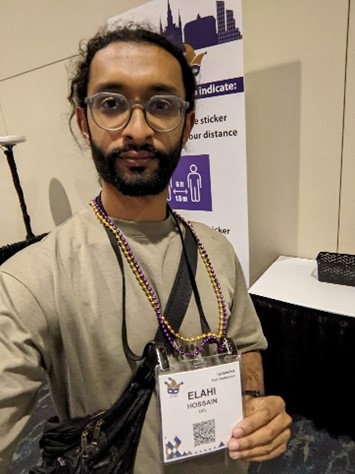
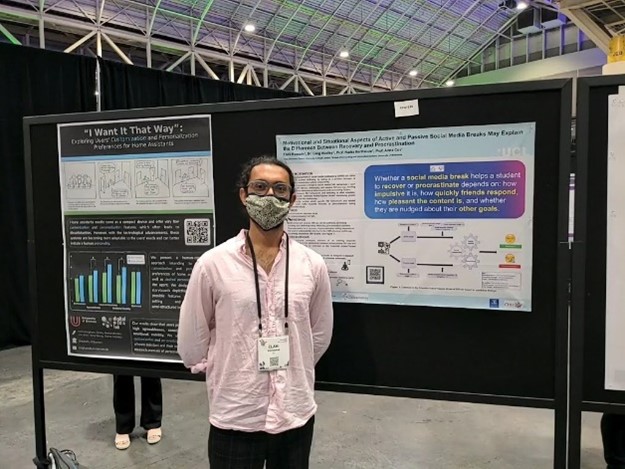
Methods for design
Whilst at CHI22 I was exposed to a range of new approaches to design through papers and poster sessions, something which I have not been exposed to as much in the PhD. This included: 1) First-person soma-based design e.g. Focusing method (Höök et al., 2021; Núñez-Pacheco & Loke, 2022; Ståhl et al., 2021);
2) User-oriented co-design methods/frameworks e.g. participatory-design (Dahl & Sharma, 2022; Kornfield et al., 2022, 2022), Stanfords d.school five-stage model (Aagaard et al., 2022), heuristics e.g. for person-centred digital coaching interventions (Ryan et al., 2022), and research through design – how to balance top-down theory with bottom-up user data (Gaver, 2012);
3) Speculative design methods e.g. pre-visualizations (Ivanov et al., 2022);
4) Repertoires (actions to increase nonhuman participation in the design process) (Oogjes & Wakkary, 2022); and
5) Niche design maxims e.g. Gricean Maxims for chatbot conversational behaviour (Setlur & Tory, 2022).
These new methods of design have left me utterly inspired. I am now rethinking how I can go about designing a new digital tool as part of my PhD – opting to more seriously consider a ‘bottom-up’ approach to the design that prioritises the user’s expertise, rather than taking a solely ‘top-down’ theoretical approach. I envision this occurring through multiple design workshops with users to both ideate and evaluate potential design solutions (Steen et al., 2008).
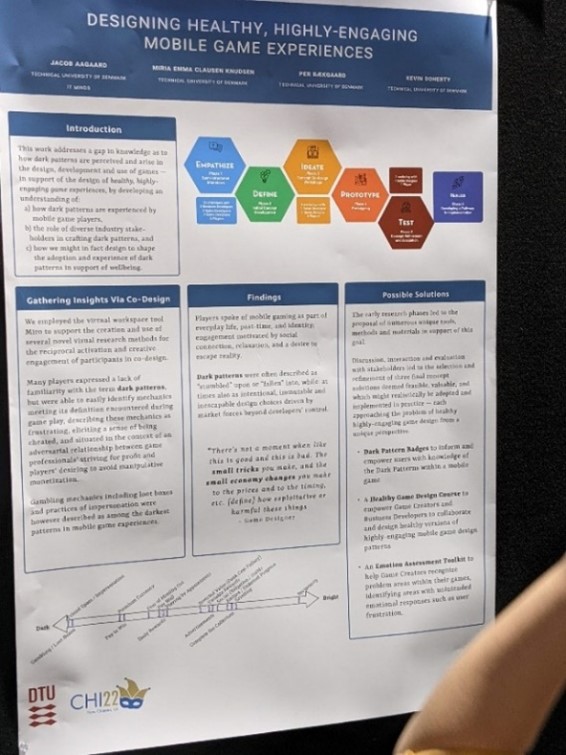
Digital emotion regulation / self-regulation
Because my PhD has a focus on emotion regulation, I also looked for other research on the same topic. I was exposed to a range of interventions that integrated an emotion regulation/self-regulation lens which ranged from tangible devices (Bou Ghanem & Yoon, 2022; Daudén Roquet et al., 2022) to digital tools for emotion-regulation (Chen et al., 2022; Howe et al., 2022) and self-regulation of digital technology in general (Xu et al., 2022).
Sense of agency and Mindfulness
These concepts came up a lot across CHI22 and seem to be heavily linked with my findings that the automaticity/autonomy of digital behaviour is strongly linked to wellbeing.
A sense of agency/control may be an important aspect of user experience (Bergström et al., 2022). I saw digital interventions increase users’ sense of agency during social media use (Zhang et al., 2022), investigations on how mindfulness practices are best incorporated into digital technologies (Li & Leshed, 2022), and the features that detract from these concepts e.g. dark patterns (Aagaard et al., 2022; Monge Roffarello & De Russis, 2022); often these concepts were situated in digital distraction:
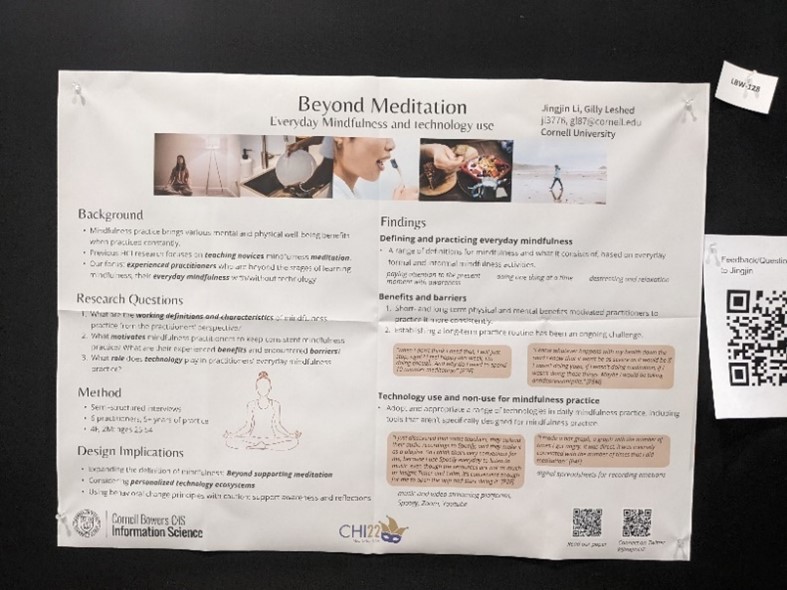
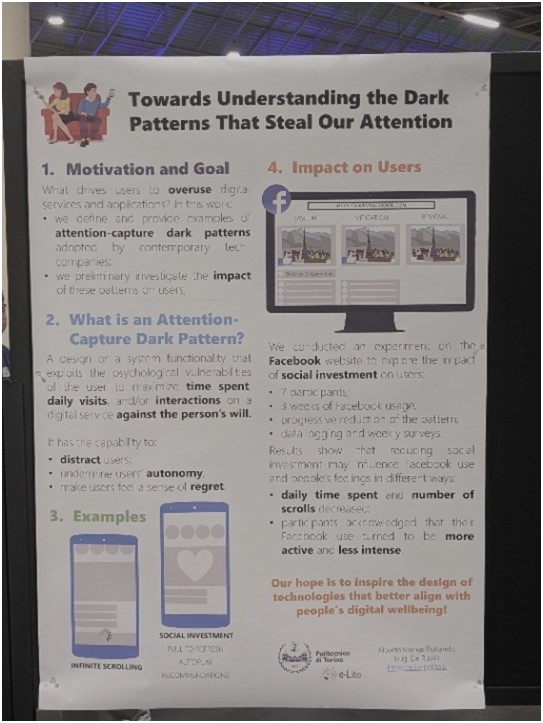
Moving from a PhD into industry
I’m still on the fence as to the direction I want to head after the PhD: academia or industry. Whilst at CHI22 I attended a talk by Google about moving from a PhD into an industry role. The talk was given by two recent PhD students now working as UX researchers at Google. It covered definitions: what is a UX researcher? What life is like within industry versus academia, and what skills acquired from a PhD are desired in industry.
These are the bullet points I noted down on my phone whilst listening:
| – context is key – iterative product design – translate research experiences: technical skills communication skills: v important to be open to different audiences, time and project management – Cross functional collaboration empathy is key: – articulate research design rationale: strength and limitations – cv: make clear research design, impact, stakeholders |
References
Aagaard, J., Knudsen, M. E. C., Bækgaard, P., & Doherty, K. (2022). A Game of Dark Patterns: Designing Healthy, Highly-Engaging Mobile Games. CHI Conference on Human Factors in Computing Systems Extended Abstracts, 1–8. https://doi.org/10.1145/3491101.3519837
Bergström, J., Knibbe, J., Pohl, H., & Hornbæk, K. (2022). Sense of Agency and User Experience: Is There a Link? ACM Transactions on Computer-Human Interaction, 29(4), 28:1-28:22. https://doi.org/10.1145/3490493
Bou Ghanem, M., & Yoon, J. (2022). Variapsody: Creating Three Interactive Music Listening Experiences that Use Diversified Positive Emotion Regulation Strategies to Promote Subjective Well-being. CHI Conference on Human Factors in Computing Systems Extended Abstracts, 1–7. https://doi.org/10.1145/3491101.3519743
Chen, S.-C., Chang, Y.-H., Huang, J.-H., Hsu, C.-W., Lin, C.-H., & Kuo, P.-Y. (Patricia). (2022). Exploring the Effect of Emotion Awareness Intervention on Reducing FoMO. CHI Conference on Human Factors in Computing Systems Extended Abstracts, 1–7. https://doi.org/10.1145/3491101.3519839
Dahl, Y., & Sharma, K. (2022). Six Facets of Facilitation: Participatory Design Facilitators’ Perspectives on Their Role and Its Realization. CHI Conference on Human Factors in Computing Systems, 1–14. https://doi.org/10.1145/3491102.3502013
Daudén Roquet, C., Theofanopoulou, N., Freeman, J. L., Schleider, J., Gross, J. J., Davis, K., Townsend, E., & Slovak, P. (2022). Exploring Situated & Embodied Support for Youth’s Mental Health: Design Opportunities for Interactive Tangible Device. CHI Conference on Human Factors in Computing Systems, 1–16. https://doi.org/10.1145/3491102.3502135
Gaver, W. (2012). What should we expect from research through design? Proceedings of the SIGCHI Conference on Human Factors in Computing Systems, 937–946. https://doi.org/10.1145/2207676.2208538
Höök, K., Benford, S., Tennent, P., Tsaknaki, V., Alfaras, M., Avila, J. M., Li, C., Marshall, J., Roquet, C. D., Sanches, P., Ståhl, A., Umair, M., Windlin, C., & Zhou, F. (2021). Unpacking Non-Dualistic Design: The Soma Design Case. ACM Transactions on Computer-Human Interaction, 28(6), 40:1-40:36. https://doi.org/10.1145/3462448
Howe, E., Suh, J., Bin Morshed, M., McDuff, D., Rowan, K., Hernandez, J., Abdin, M. I., Ramos, G., Tran, T., & Czerwinski, M. P. (2022). Design of Digital Workplace Stress-Reduction Intervention Systems: Effects of Intervention Type and Timing. CHI Conference on Human Factors in Computing Systems, 1–16. https://doi.org/10.1145/3491102.3502027
Ivanov, A., Au Yeung, T., Blair, K., Danyluk, K., Freeman, G., Friedel, M., Hull, C., Hung, M. Y.-S., Pratte, S., & Willett, W. (2022). One Week in the Future: Previs Design Futuring for HCI Research. CHI Conference on Human Factors in Computing Systems, 1–15. https://doi.org/10.1145/3491102.3517584
Kornfield, R., Meyerhoff, J., Studd, H., Bhattacharjee, A., Williams, J. J., Reddy, M., & Mohr, D. C. (2022). Meeting Users Where They Are: User-centered Design of an Automated Text Messaging Tool to Support the Mental Health of Young Adults. CHI Conference on Human Factors in Computing Systems, 1–16. https://doi.org/10.1145/3491102.3502046
Li, J., & Leshed, G. (2022). Beyond Meditation: Everyday Mindfulness and Technology Use. CHI Conference on Human Factors in Computing Systems Extended Abstracts, 1–6. https://doi.org/10.1145/3491101.3519820
Monge Roffarello, A., & De Russis, L. (2022). Towards Understanding the Dark Patterns That Steal Our Attention. CHI Conference on Human Factors in Computing Systems Extended Abstracts, 1–7. https://doi.org/10.1145/3491101.3519829
Núñez-Pacheco, C., & Loke, L. (2022). Focusing for Interaction Design: An Introspective Somatic Method. CHI Conference on Human Factors in Computing Systems, 1–18. https://doi.org/10.1145/3491102.3501978
Oogjes, D., & Wakkary, R. (2022). Weaving Stories: Toward Repertoires for Designing Things. CHI Conference on Human Factors in Computing Systems, 1–21. https://doi.org/10.1145/3491102.3501901
Ryan, K., Dockray, S., & Linehan, C. (2022). Understanding How eHealth Coaches Tailor Support For Weight Loss: Towards the Design of Person-Centered Coaching Systems. CHI Conference on Human Factors in Computing Systems, 1–16. https://doi.org/10.1145/3491102.3501864
Setlur, V., & Tory, M. (2022). How do you Converse with an Analytical Chatbot? Revisiting Gricean Maxims for Designing Analytical Conversational Behavior. CHI Conference on Human Factors in Computing Systems, 1–17. https://doi.org/10.1145/3491102.3501972
Ståhl, A., Tsaknaki, V., & Balaam, M. (2021). Validity and Rigour in Soma Design-Sketching with the Soma. ACM Transactions on Computer-Human Interaction, 28(6), 38:1-38:36. https://doi.org/10.1145/3470132
Steen, M., de Boer, J., Kuiper-Hoyng, L., & Visser, F. S. (2008). Co-design: Practices, challenges and lessons learned. Proceedings of the 10th International Conference on Human Computer Interaction with Mobile Devices and Services – MobileHCI ’08, 561. https://doi.org/10.1145/1409240.1409350
Xu, X., Zou, T., Xiao, H., Li, Y., Wang, R., Yuan, T., Wang, Y., Shi, Y., Mankoff, J., & Dey, A. K. (2022). TypeOut: Leveraging Just-in-Time Self-Affirmation for Smartphone Overuse Reduction. CHI Conference on Human Factors in Computing Systems, 1–17. https://doi.org/10.1145/3491102.3517476
Zhang, M. R., Lukoff, K., Rao, R., Baughan, A., & Hiniker, A. (2022). Monitoring Screen Time or Redesigning It? Two Approaches to Supporting Intentional Social Media Use. CHI Conference on Human Factors in Computing Systems, 1–19. https://doi.org/10.1145/3491102.3517722
Crowdworkers’ temporal flexibility is being traded for the convenience of requesters through 19 ‘invisible mechanisms’ employed by crowdworking platforms
This year at CHI2022 we will be presenting our work that explores how the design of crowdworking platforms impacts the amount of temporal flexibility experienced by workers on the platforms. You can see the Late Breaking Work paper here
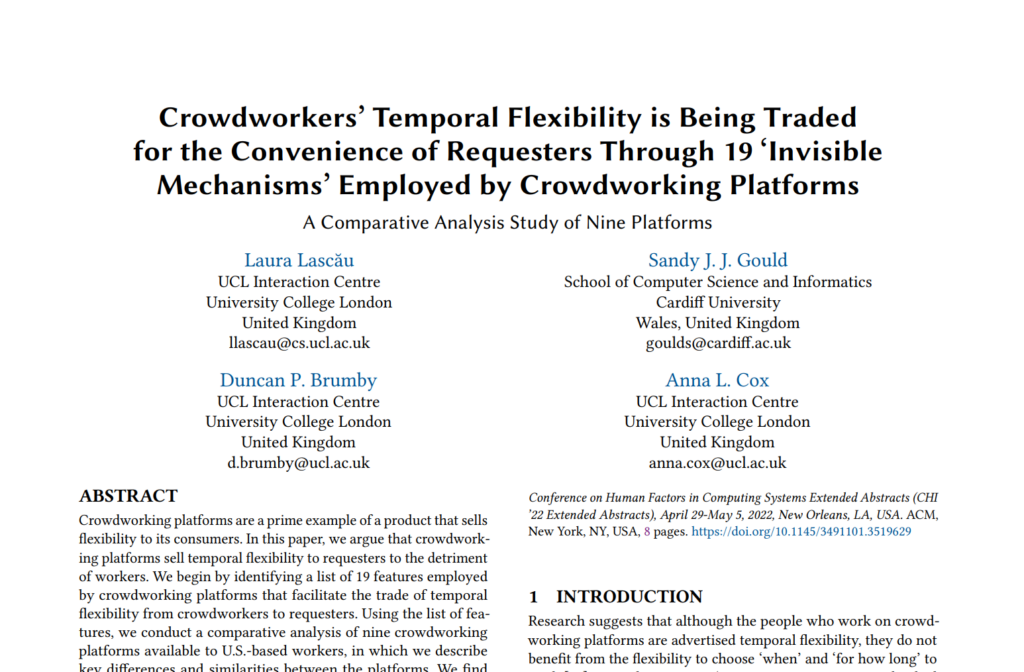
We find that:
- Crowdworking platforms strongly favour features that promote requesters’ temporal flexibility over workers’ by limiting the predictability of workers’ working hours and restricting paid time. The results of our study show the different ways in which the values held by the customers of the technology (i.e., requesters), instead of the values of those impacted by the technology (i.e., workers), can be embodied consciously or unconsciously by technology
- Using the temporal precarity scores that we calculated, we identified which platforms available to U.S.-based workers employed the highest number of features that facilitated the trade of flexibility from workers to requesters, consequently increasing workers’ temporal precarity. These are useful for two reasons. First, the people working on crowdworking platforms can benefit from having increased awareness about the exploitative mechanisms of crowdworking platforms, although they might have little power to change them. Second, requesters can also benefit from reflecting on the power asymmetries perpetuated by crowdworking platforms when choosing which platforms to use in their work.
You can watch a 3 minute video summary of the paper here:
A Workshop & 2 SIGs accepted for CHI 2022
The eWorkResearch group will be involved in three academic community building events at CHI 2022.
- A workshop titled The Future of Emotion in Human-Computer Interaction
2. A special interest group (SIG) meeting titled Moving from BCI to Personal Cognitive Informatics
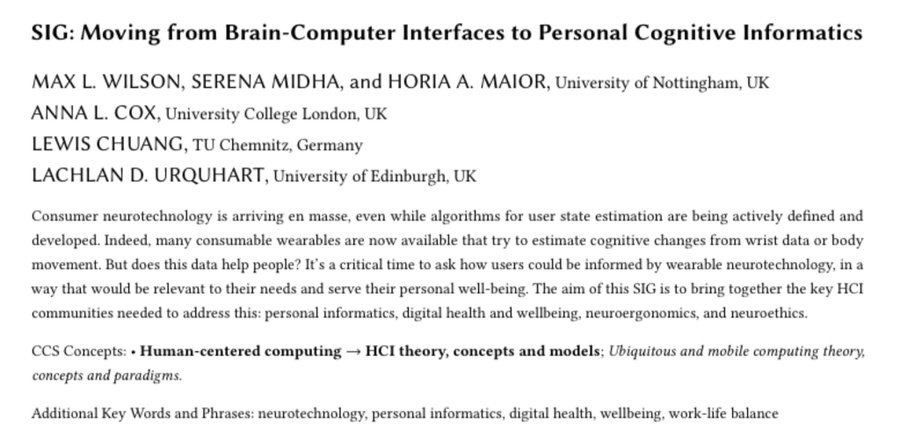
3. A special interest group meeting titled Human-Computer Interaction and the Future of Work. Find out more about this at the CHIWORK website
Email Charter
We can help reverse the problems caused by email overload. Be part of the solution.
1. Respect recipients’ time
Make your email easy to read: use these plain English tips to save others time AND make your communication more effective.
2. Short is not rude
It’s ok to be brief. Don’t take brevity personally and know that others won’t. Wordy responses take longer to read. People will scan it and are less likely to read it all; key details can be easily missed.
3. Celebrate clarity
Subject line: write a short subject line that clearly gives the topic.
Opening line: make it the basic reason for writing.
4. Slash CCs
Only CC someone who really needs this message. Don’t thoughtlessly ‘Reply all’: choose individual recipients.
5. Tighten the thread
If you need to include the email trail showing the context, cut what’s not relevant. If it’s long, summarise or make a phone call instead.
6. Reduce attachments
Don’t use images like logos in your signature – they’ll be attached and I’ll try to open it in case it’s something relevant.
7. Should we expect an instant response?
Don’t feel you need to give an instant response, and don’t expect to get one. Skype or the telephone are your tools if something is urgent.
8. Disconnect sometimes
Can you calendar half-days for email-free working? And you should be having email-free evenings, weekends, holidays. Have an ‘auto-response’ that makes it clear you’re not checking.
9. Reference this charter
Spread the word and help change email culture. Reference this charter in your email footer.
This charter was adapted from emailcharter.org which as of 18 Jan 2019 seems to have died. 🙁 This text was copied from the University of Kent’s website who have kept the email charter alive.
There is more information about the email charter at theTEDBlog
COVID Ward
A blogpost by Emma Holliday, student on MSc HCI 2019-2021

Getting into the video games industry was originally my inspiration for studying Computer Science. As I learned about the often toxic work environments (and sexism) in the gaming industry, I decided to leave this dream behind and went into software development instead. That’s why I’m so amazed and thrilled to have actually designed and built my own game and, even better, to have won an award for it.
Click here to play the game! Spoilers below!
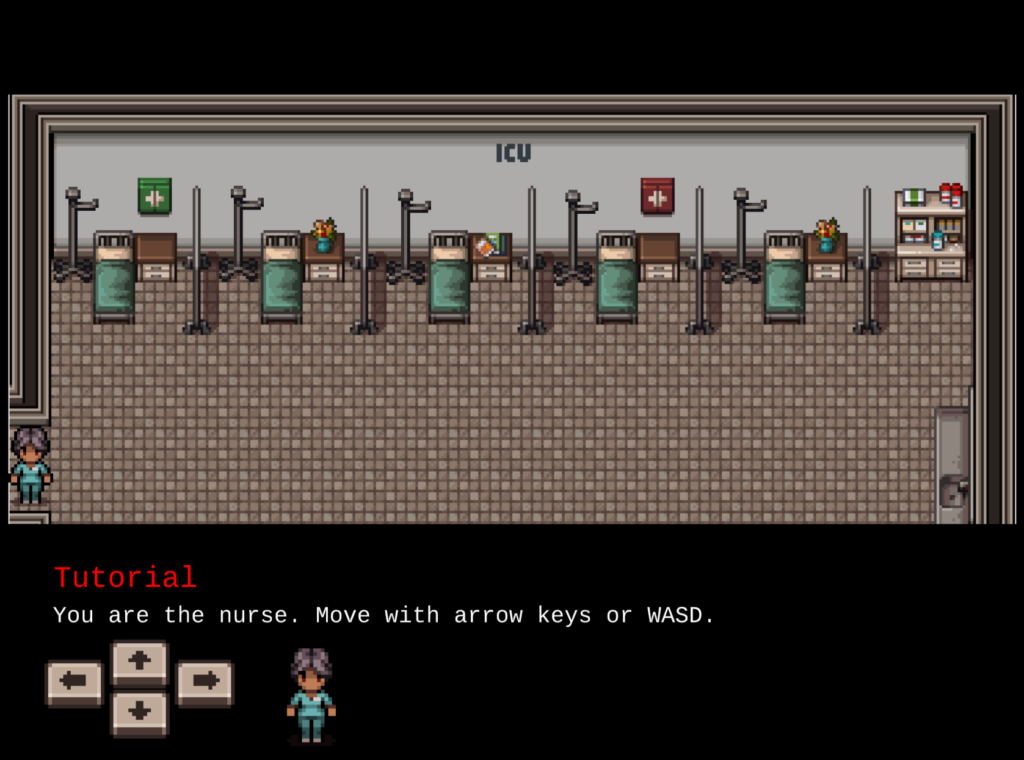
The game itself was built as part of my coursework for the Serious and Persuasive Games module (led by Prof Anna Cox) on the Human-Computer Interaction course at UCL. (Even though I had somewhat given up on a career in the gaming industry, I still really loved games and would take any excuse to learn about them and play them.) Something that really stood out to me during the lectures was the concept of the “Magic Circle”, an idea that games exist within set boundaries that are separate to the real world. This means that different rules apply within game (e.g. violence is allowed), actions in the game don’t have consequences in the real world, and actions in the real world don’t apply to the game. I immediately challenged this – I’m sure we’ve all had that gaming session that left friendships a little sour even after the game had finished, learnt something new or even strengthened our relationships. I personally believe, particularly with narrative-based games, it is very unlikely to not leave some lasting impression in the real world long after the game has been played. As such, I designed a game that would exploit breaking the “Magic Circle” by including people’s real-world actions into gameplay. My hopes were that, by breaking the “Magic Circle” upfront, this would weaken the boundaries between the game and the real world, encouraging players to take experiences from the game back into real life.
My time studying this module was during the COVID-19 pandemic which also provided a lot of inspiration, largely because it was inescapable and incredibly topical. Other games which we studied during the module were also influential, particularly those on blame culture in nursing (such as Nurse’s Dilemma and Patient Panic). All of this culminated in my game, COVID Ward, where players take on the role of a nurse working in the intensive care unit during the COVID-19 pandemic. The gameplay is quite simple, players use arrow keys to control the nurse and spacebar to administer aid to patients in the ward. Patient health deteriorates over time and they will eventually die if their health becomes too low while fully healed patients are able to leave the ward. The game plays out as levels representing 12 hour shifts, so time is limited and the nurse character can only do so much in a day. In between levels is where the “Magic Circle” is broken; the player is asked a question relating to their real-world actions during the pandemic and their answer affects the number of patients admitted to the ward during the next level. For example, the question may ask if the player always wore a mask while on public transport. If the player answers “no”, there would be more patients in the ward the next day than if they had answered “yes”. Through this, players see the their actions directly associated with the effects on other people and healthcare staff.
The game was refined iteratively thanks to playtesting with my friends, fellow students, and staff on the Serious and Persuasive Games course. Finally, a user study was completed to test if the game had the desired effects of making people feel more responsible for their actions, encouraging them to follow COVID-19 safety guidance more closely and increasing empathy for nursing staff. Though it was a small scale study, initial results were very positive and suggested that the game had achieved its goal in terms of attitude change. Qualitative responses from participants repeatedly mentioned the use of their real world actions and suggested it was both engaging and encouraged them to reflect more deeply on their actions. As such, breaking the “Magic Circle” is a promising technique for persuasive games which warrants further research.
In terms of development, the game was built using Game Salad (a no-code game authoring tool). Though I’m familiar with code, (and there were times I wished I was using code!) GameSalad did provide a really quick way to get started and put ideas together without too much learning overhead. Having since tried to pick up Unity, I can say Game Salad is definitely a lot quicker to get your ideas into something working, which is crucial for iterative development. Game Salad also made it very easy to publish my game so that others could play it online, which helped enormously when getting feedback and conducting the user study as there was no installation or downloads required.
In an early version of the game, everything was represented by incredibly simple shapes and numbers. While I support the concept of primarily using the mechanic to deliver the message, as demonstrated remarkably in Brenda Romero’s games, I felt my game would benefit from graphics and sound effects to help immerse the player and reinforce the narrative that these were real people affected by their actions, encouraging stronger empathy. Given the short time frame (and that I am only one person who is not talented enough to do everything from scratch!) I was exceedingly grateful for assets created by other artists which allowed me to create something that was much more complete than I could have achieved on my own. I found the music by Bio_Unit on Free Music Archive and got sound effects from Kenney.nl (a fantastic source for several free assets!) I paid for some pixel-art assets from Malibu Darby through Humble Bundle which, very fortunately, had a game dev bundle just as I was building the game. I also dabbled in editing the pixel art myself to customise it to my game. If you’d like to give that a go, I recommend aseprite.
Overall, I was really happy with my game and the results of the user study. Prof. Anna Cox had suggested that the class submit their work to the CHI PLAY student game competition. Earlier in my time at UCL, Prof. Catherine Holloway had encouraged us to always try and share our work with the academic community and introduced me to Student Research Competitions. These are often held across different ACM conferences (such as SIGCHI, SIGACCESS, CHIPLAY) and felt much more approachable to me as the level of work expected was closer to what I had already done for my coursework. As such, I decided to go for it and submit my game and a paper detailing the user study to CHI PLAY 2021’s Student Game Design Competition. I didn’t really expect to win anything, but I was just happy to share my game in the hopes it might have a life beyond my university coursework grades.
So I was very excited when I heard back to find out my game had been accepted! It turns out, 8 of the 19 submissions were accepted to the conference as finalists. This did mean, however, that I had a bit more work to do! I updated my paper to respond to the reviewers’ comments, battled with the proper formatting and TAPS submission system (though the support staff are really helpful), and created a reaction video to be played at the conference. I’d be lying if I said it wasn’t stressful (largely because it fell right across the deadline for my final MSc dissertation!!) but it was definitely worth it to see my work presented at the conference and all the interest it generated. Even more so when I was announced as receiving an honourable mention for the competition! I also got to attend the entire conference – though you don’t have to be an author to do so – and joined lots of interesting talks and presentations across all aspects of games.

It was really rewarding finding myself back in the games industry, in a sense, but from a completely different direction than I had ever imagined and one that was much better suited to me and my passions. It was even more rewarding to know that I had contributed to it and that, maybe one day, my research will have an impact on the games I end up playing on my sofa.
Find out more about the competition and see the other entries

